MARIANI’SVirtual
Gourmet
June 8, 2014
NEWSLETTER

IN THIS ISSUE
WINDING OUR WAY TO RAVELLO
By John Mariani
NEW YORK CORNER
THE HARRISON and THE LIBERTY ROOM
By John Mariani
NOTES FROM THE WINE CELLAR
THE MOON AND STARS WATCH OVER THE WINES OF AVIGNONESI
❖❖❖
WINDING OUR WAY TO RAVELLO
By John Mariani
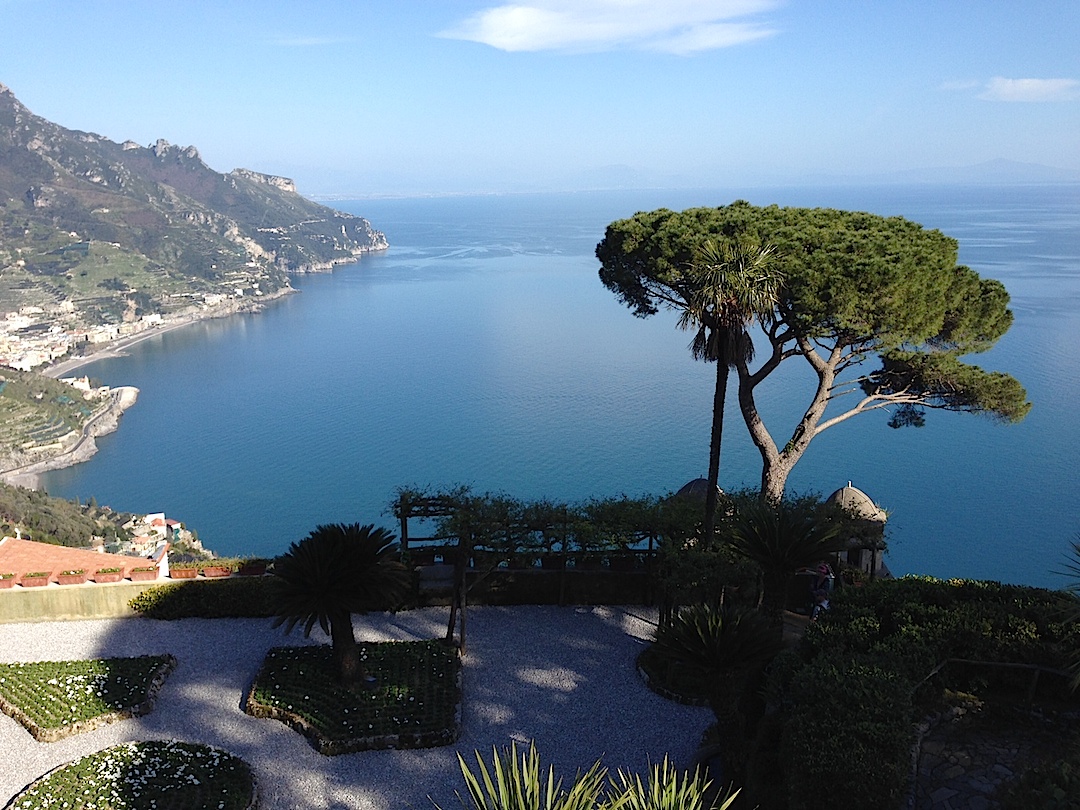
The view from Palazzo Avino
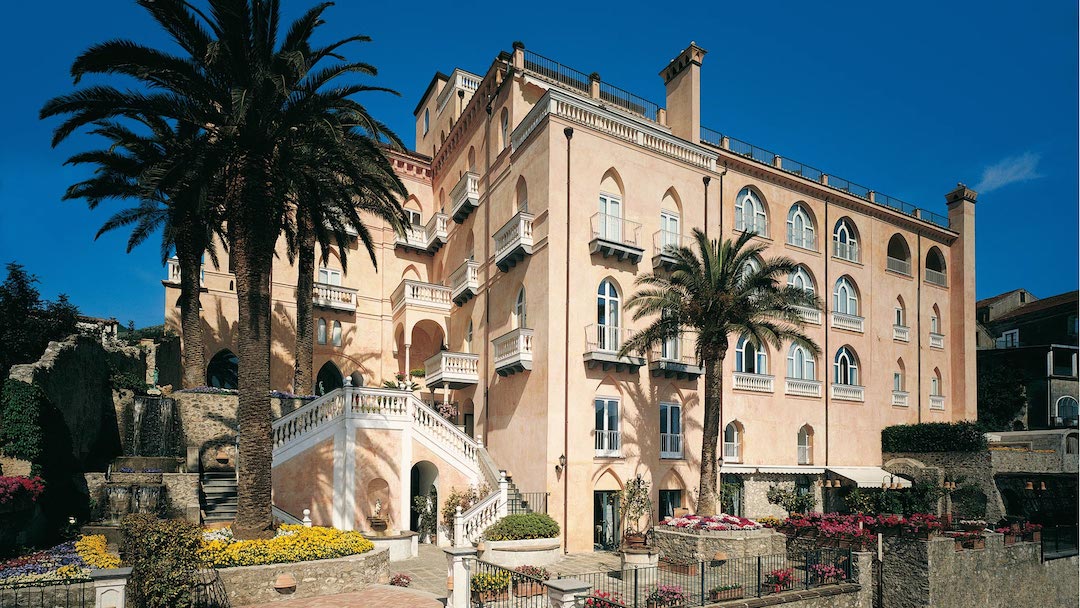 Curiously
enough, the number of accidents along this endurance
Curiously
enough, the number of accidents along this enduranceAs with so many mountain towns, Ravello was stuck so high up to
Today less than 3,000 people live in Ravello, so tourism is pretty
As you’d expect, all the rooms have been re-done, now with
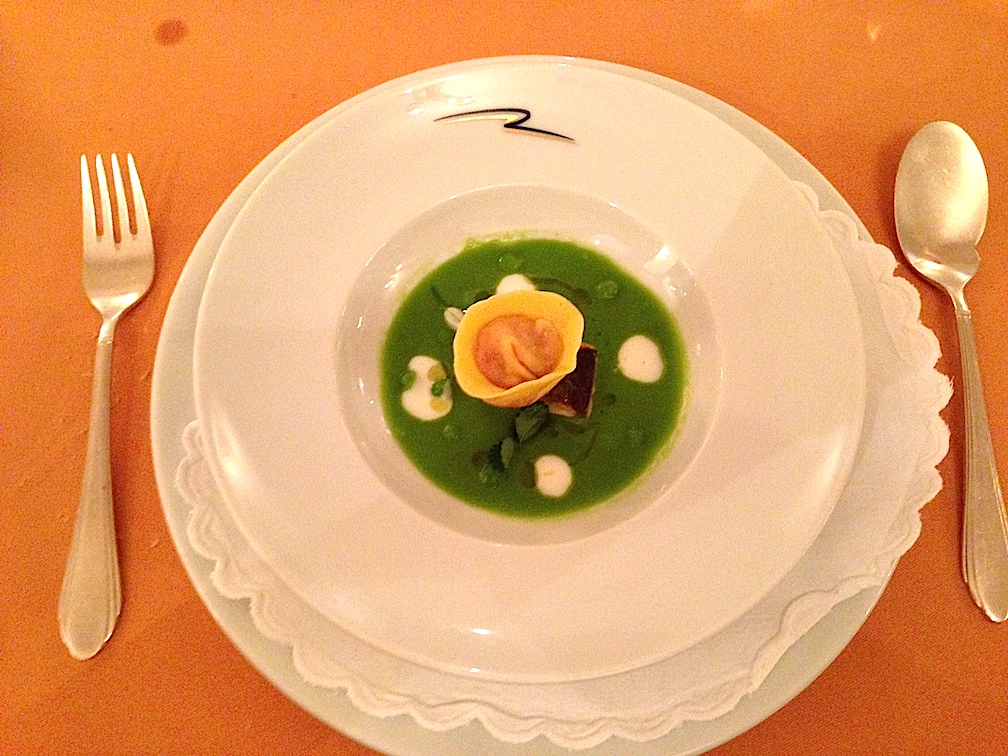 Bulgari amenities. With
Bulgari amenities. WithThe Palazzo has a new chef, Michele Deleo, born in the province, has come aboard
Deleo’s pastas are superb, though plating them with so much
Roam the hills of Ravello, through the small, quaint piazza, and
 Some of
the finer ceramics I’ve found along the Amalfi
coast--where
Some of
the finer ceramics I’ve found along the Amalfi
coast--whereRavello is not rich in restaurants outside of the grander hotels,
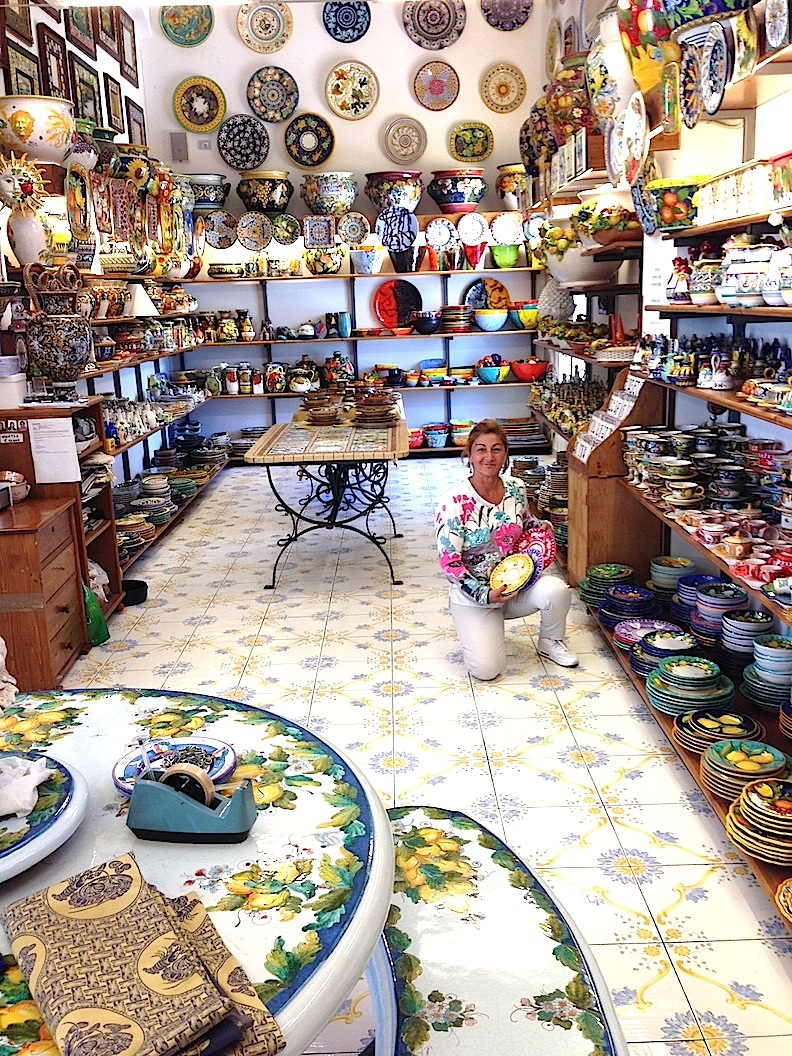 lingering
till late afternoon.
lingering
till late afternoon.A no-frills trattoria often mentioned in the guidebooks is Cumpa’
Back at the Palazzo Avino, having cocktails on the terrazza,
removed from the world’s bustle, but two, because I had little desire to
Ravello is easy to find, difficult to get to, and very sad to
❖❖❖
THE HARRISON and THE LIBERTY ROOM
By
John
Mariani
Restaurants that
have long lives never follow trends, for their
owners and chefs know that it is in the
consistency of their original ideas, whether a
Southern Italian trattoria or a New York
steakhouse, that their strength lies.
Indeed, restaurants that started out trying to
catch a cresting wave, like New Nordic or
Neo-Peruvian, rarely succeed in becoming that all
important thing--a favorite. For every
person dying to be among the first to get a table
at a buzzing new restaurant in Dumbo (down under
the Manhattan Bridge) or Losaida (Lower East
Side), there are thousands more hungry people more
excited to return again and again to their
favorite places. And in New York City,
anyone’s favorites can number in the dozens.
 The Harrison (near the
new World Trade Center) and The Liberty Room
(attached to Aureole on West 42nd Street) are
anything but dated, though their menus and chefs
de cuisine change with the seasons over the years.
There is a well-focused consistency in the style
of cuisine, with new flourishes all the time, that
keeps them always in the forefront of people’s
minds if not on the lists of the hottest
restaurants of the week.
The Harrison (near the
new World Trade Center) and The Liberty Room
(attached to Aureole on West 42nd Street) are
anything but dated, though their menus and chefs
de cuisine change with the seasons over the years.
There is a well-focused consistency in the style
of cuisine, with new flourishes all the time, that
keeps them always in the forefront of people’s
minds if not on the lists of the hottest
restaurants of the week.
Chef-Restaurateur Jimmy
Bradley opened The
Harrison (left) at the
worst of times, just weeks after the events of
9/11, but it proved to be a beacon of hope and
resilience in that devastated neighborhood, as
much by simply keeping the lights on as by serving
modern American comfort food people craved.
Now, more than a decade later, the modestly sized
corner restaurant teems with regulars day and
night.
The dining room has an
unassuming charm, with cream-colored walls, dark
wood and slender pillars, with a convivial but not
overly loud walnut bar, and superbly flattering
lighting. The reception is always just as
warm and inviting. It’s a look and form of
hospitality that would be welcomed anywhere, from
Boulder to Birmingham, and fits into downtown New
York like the setting for an O. Henry story.
Since January,
Executive Chef Ari Bokovza has been both
maintaining and fine-tuning the menu with his own
ideas. I seem to recall that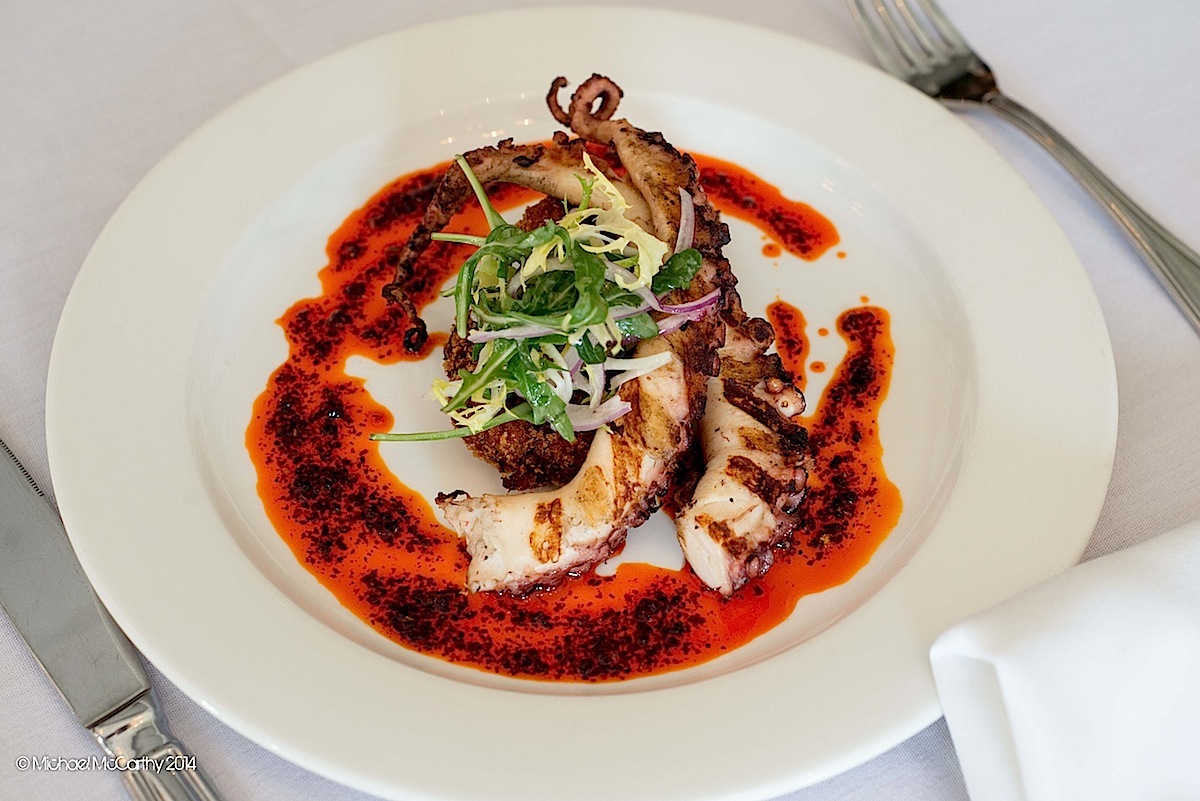 the crispy gnocchi
has long been a staple at The Harrison, and it was
as good as ever, with a rich duck confit, hen of
the woods mushrooms and walnut pesto.
Grilled octopus (right),
which is everywhere these days, here gets a novel
accompaniment of sweet potato falafel and a
bracing shot of hot harissa condiment.
the crispy gnocchi
has long been a staple at The Harrison, and it was
as good as ever, with a rich duck confit, hen of
the woods mushrooms and walnut pesto.
Grilled octopus (right),
which is everywhere these days, here gets a novel
accompaniment of sweet potato falafel and a
bracing shot of hot harissa condiment.
Seafood and
meats vie for equal attention on the menu, for
it’s hard to choose between Chatham cod in a bath
of fish chowder with fresh spring peas and sweet
onions, and one of my favorites, sautéed
calf’s liver, sliced to the right thickness, with
bacon and onion tart, dashed with a Sherry vinegar
sauce that brightens the richness of the meat and
bacon.
There is a new
pastry chef coming aboard soon, so I hesitate to
recommend desserts I enjoyed, but, given the way
The Harrison has always been, the style of
delicious, homey desserts of the past should be
intact.
If I lived in
the area, The Harrison would be my go-to place;
the fact that I don’t means I can always go back
and be reminded of what I’ve
always loved about it.
The
Harrison is at 355 Greenwich Street; 212-274-9310;
. Appetizers
$12-$17, entrees $24-$41. Open Lunch Mon.-Fri.,
dinner nightly; brunch Sat. & Sun.
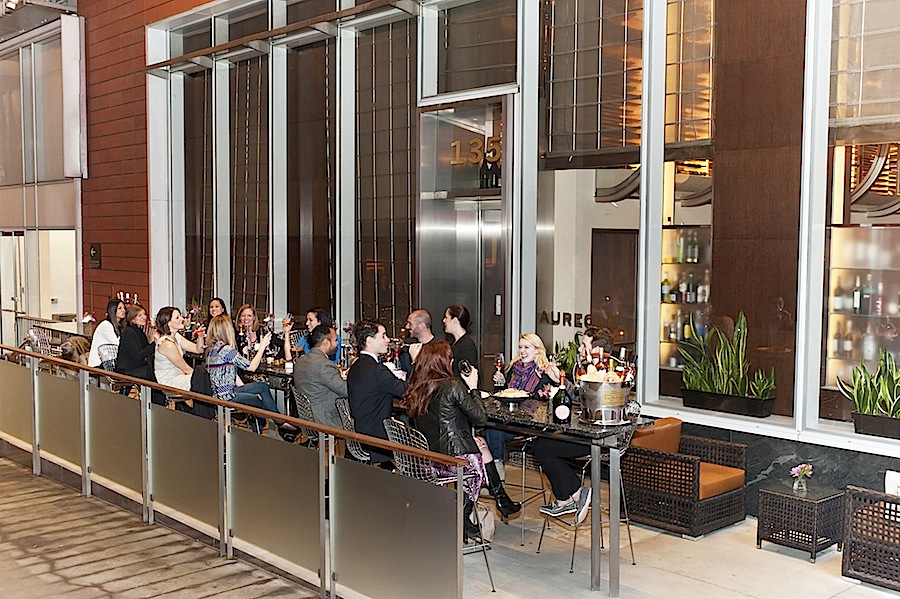 The
Liberty Room is
the new name for the barroom at restaurateur
Charlie Palmer’s classically elegant Aureole, near
Bryant Park. Its origins go back 25 years to
another location, and today it is rightly
considered one of the classic dining rooms of a
genteel New York, especially noted for its
nonpareil wine list.
The
Liberty Room is
the new name for the barroom at restaurateur
Charlie Palmer’s classically elegant Aureole, near
Bryant Park. Its origins go back 25 years to
another location, and today it is rightly
considered one of the classic dining rooms of a
genteel New York, especially noted for its
nonpareil wine list.
The Liberty Room now opens onto
a 600-square-foot al fresco patio (left) that
right now is perfect for a late spring pre-theater
dinner, cocktails or bite after work, and its
location on West 42nd Street reminds you of the
old song, “Little nifties from the Fifties
innocent and sweet,/ Sexy ladies from the
Eighties, who are indiscreet./ They're side by
side, they're glorified,/Where the underworld can
meet the elite, Forty-Second Street./Naughty,
bawdy, gaudy, sporty, Forty Forty-Second
Street!” This is People Watching Central.
Inside are shiny walnut-topped
tables and a bar back-lit and with etched glass. A
highlight of the contemporary menu--and by no
means a light item--is Chef Marcus Gleadow-Ware’s
signature Liberty Duck Casserole (below),
exclusively offered to Liberty Room diners, and,
with Swiss chard, fava beans, marble potatoes, and
orange, it is as wondrous and delicious a dish as
you’ll find  in New
York right now, easily feeding two, perhaps even
three people. I also loved his foie gras mousse,
his smoky pulled pork sliders, and finely chopped
tuna tartare with fennel, espelette pepper, and
taro root chips. Crispy shrimp with
cauliflower and basil aïoli was all right,
though the shrimp themselves lacked flavor.
in New
York right now, easily feeding two, perhaps even
three people. I also loved his foie gras mousse,
his smoky pulled pork sliders, and finely chopped
tuna tartare with fennel, espelette pepper, and
taro root chips. Crispy shrimp with
cauliflower and basil aïoli was all right,
though the shrimp themselves lacked flavor.
Don’t miss any dessert here
that involves chocolate, like the crèmeux
with salted caramel, “Aureo” cookie and chocolate
sorbet, but for something more summery, go for the
Meyer lemon parfait with a touch of basil,
hibiscus gelée and grapefruit sorbet.
Palmer is a chef-restaurateur
who makes the kind of food people will always love
without needing to puzzle out what it is, and
that, in the long run, is what makes a great place
to eat every time.
The Liberty
Room at Aureole is at One Bryant Park, 135 West
42nd Street; 212-319-1660; ; Open for
lunch Mon.-Fri., dinner nightly; Patio bites
$6-$18; Liberty Room dinner appetizers $14-$24,
main courses $29-$72 (for duck for two).
❖❖❖
THE MOON AND STARS WATCH OVER THE WINES OF AVIGNONESI
By John Mariani
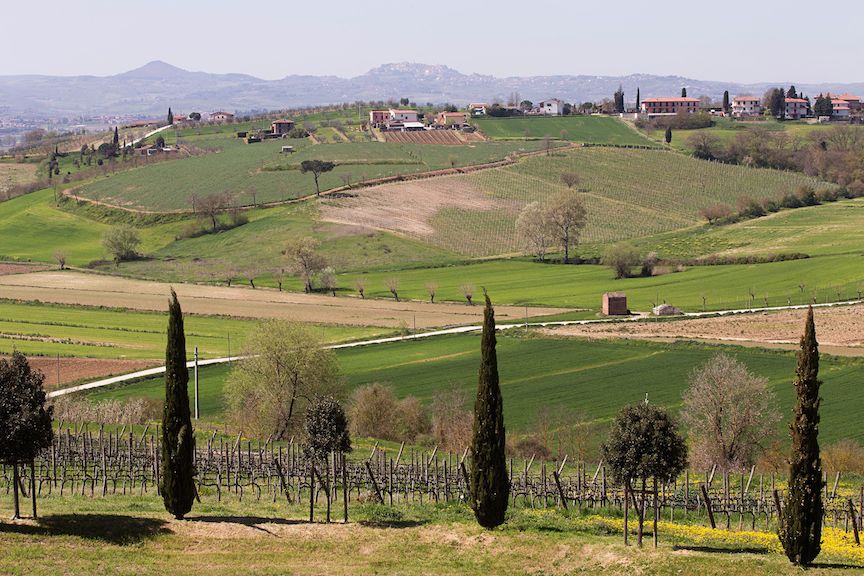 The
sun and moon shine over the vineyards of
Avignonesi (left)
as they do everywhere else in
Tuscany, but the owner and winemakers of this
495-acre estate in Valliano di
Montepulciano probably spend more time looking
up at the sky than do their neighbors
at other vineyards.
The
sun and moon shine over the vineyards of
Avignonesi (left)
as they do everywhere else in
Tuscany, but the owner and winemakers of this
495-acre estate in Valliano di
Montepulciano probably spend more time looking
up at the sky than do their neighbors
at other vineyards.
When
Virginie Saverys (below) took over the ownership
of the property in 2009, after years
as a silent partner, she and winemakers Matteo
Giustiniani and Ashleigh Seymour
adopted the motto, “Terroir speaks; we listen.” That in itself does
not make Avignonesi distinct in
Tuscany, but the estate’s commitment to being
certified 100 percent organic and
to following the sometimes-controversial concepts
of biodynamics put it in a
smaller pool. “We are the stewards
of the land on which we grow our vines,” says
Belgian-born Saverys, “In order
to create the healthiest growing habitat for our
grapes, we must let the
vineyards imitate nature as far as possible,
despite the fact that they 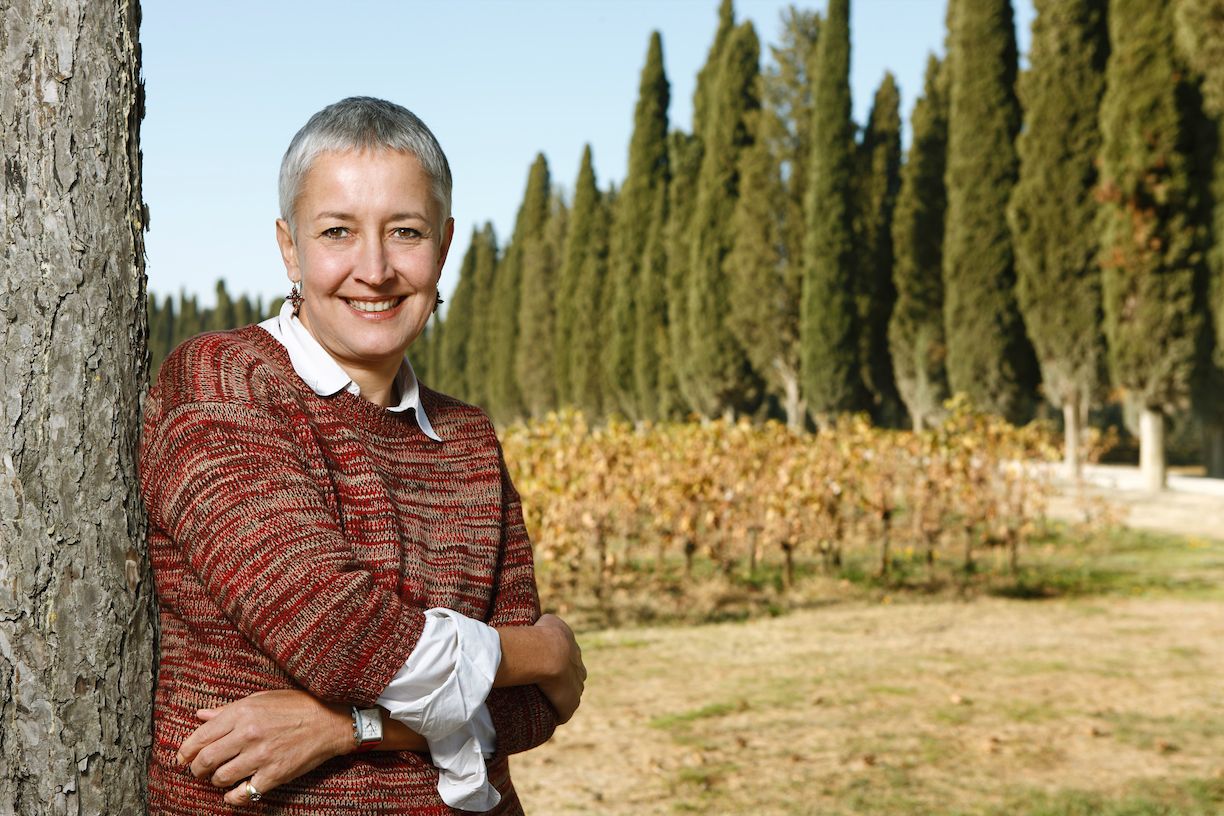 are
monocultures.”
are
monocultures.”
Biodynamics,
first proposed by Austrian philosopher and
scientist Rudolph Steiner, now
includes many of the most modern approaches to
winemaking, based on a
philosophy that the world’s ecosystem demands
paying attention to the natural
order, including phases of the moon and the
position of the sun as they affect
the climate and soil of a microclimate like Tuscan
vineyards. Avignonesi’s
insistence that terroir
speaks and the winemakers listen makes the use of
synthetic fertilizers and
pesticides anathema to healthy vineyards.
Avignonesi
is also committed to bringing the traditional red
wine called Vino Nobile di
Montepulciano to greater eminence among Sangiovese
grape-based Tuscan wines,
while eschewing the meaningless market term “Super
Tuscan.”
Vino Nobile di Montepulciano has long
had respect among connoisseurs but like Cinderella
stayed in the shadow of
better promoted Tuscan wines like Brunello di
Montalcino, Ornellaia,
Tignanello, and Sassicaia, some made with Cabernet
Sauvignon.
Avignonesi’s
Vino Nobiles are 100 percent Sangiovese, even
though Italian wine laws allow 30
percent other grapes to be added to the wine. Belgian-born Virginie
Saverys states unequivocally, “I say
no! It would make life easier to add some Merlot
to Sangiovese, but I accept
the challenge to make ours wholly Sangiovese. The
easy route is not always the
good route.
And now we are dealing
with global warming. I have one
wine at 15 percent alcohol and that is too high.”
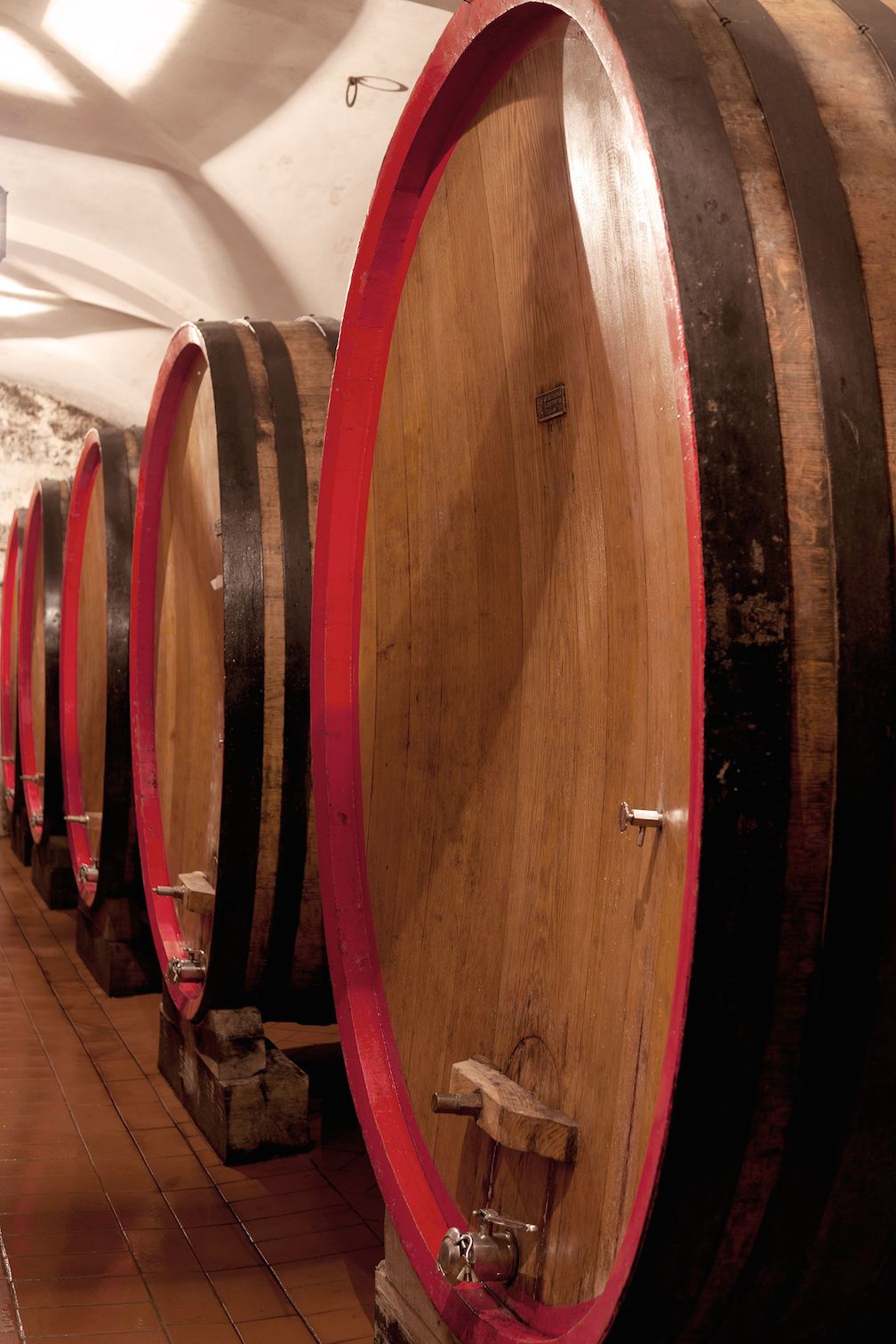 Long
in
love with Tuscany, Saverys has brought a
formidable curriculum vitae to
Avignonesi: born in Ghent and graduated from law
school in Paris, she rose to
the top ranks of a law firm but decided her work
was becoming too corporate. “I
resigned in 2006 because I didn’t want to be a
policeman,” she says. “I like deal
making.”
Long
in
love with Tuscany, Saverys has brought a
formidable curriculum vitae to
Avignonesi: born in Ghent and graduated from law
school in Paris, she rose to
the top ranks of a law firm but decided her work
was becoming too corporate. “I
resigned in 2006 because I didn’t want to be a
policeman,” she says. “I like deal
making.”
In
buying Avignonesi, founded in 1974, she was
determined to make the finest wines
possible with the least intervention in the
vineyards and to make the estate a
kind of modern global village. “We
are not interested in the past but only in the
future,” she says. “We have 100
different nationalities working at the winery and
we have three big parties
each year for everyone.”Over
a dinner of spaghetti alla carbonara and lamb
chops at Maialino restaurant in
New York, Saverys noted that Vino Nobiles are
softer and less tannic than other
of Tuscany’s Sangioveses. Still,
she says, “I don’t want to release wines that are
not ready to drink.
The 2011 Grand Annate won’t be released
until 2015. In 2011 I did not even make the Grand
Annate because I
did not want
to over-promise and under-deliver in quality.”
because I
did not want
to over-promise and under-deliver in quality.”
Avignonesi
makes other wines beside Vino Nobile, including
the 50/50 blend of Sangiovese
and Cabernet Sauvignon called Grifi, which when
originally produced in the
1960s acquired the Super Tuscan moniker.
Another wine, Desiderio, is dominated by
Merlot from the Cortona region
and is named after the robust Chianina beef steers
raised in region.
I
have always found the wines of Avignonesi
impressive for their richness and
complexity, easily deserving a place next to
better-known Tuscan rivals. Now,
with Saverys and her army of 100
workers from 21 counties, the winery is poised to
push Vino Nobile into the highest
ranks of recognition for Italian wine.
Of
this, Saverys has no doubt. “I was recently in
China,” she said, slightly
smiling, “and the Chinese are becoming very
interested in Italian wines. I met
some very young, very eager Chinese who spoke
excellent English and they told
me there are now many wine courses in their
country being given in Mandarin. So
we are looking carefully for a distributor there.
China will be a huge market,
and I want them to taste the best Italian wines. I am patient and willing to
take my time to make that
happen. ”

A
Florida woman named Barbara Kaufman says she
spent five days in a hospital's intensive care unit
after unknowingly consuming a cocktail
containing liquid nitrogen. While attending the Miami
Beach Botanical Gardens, she was served a drink
"without any instructions" or indication that she
should wait to consume it. After a single sip, Kaufman
said "Smoke was coming out of my nose and my mouth."
According to doctors, Kaufman suffered internal
burning and tears to her abdomen.
❖❖❖
Any of John Mariani's
books below may be ordered from amazon.com.
 |
The Encyclopedia of American Food and Drink by John F. Mariani (Bloomsbury USA, $35) Modesty forbids me to praise my own new book, but let me proudly say that it is an extensive revision of the 4th edition that appeared more than a decade ago, before locavores, molecular cuisine, modernist cuisine, the Food Network and so much more, now included. Word origins have been completely updated, as have per capita consumption and production stats. Most important, for the first time since publication in the 1980s, the book includes more than 100 biographies of Americans who have changed the way we cook, eat and drink -- from Fannie Farmer and Julia Child to Robert Mondavi and Thomas Keller. "This book is amazing! It has entries for everything from `abalone' to `zwieback,' plus more than 500 recipes for classic American dishes and drinks."--Devra First, The Boston Globe. "Much needed in any kitchen library."--Bon Appetit. |
"Eating Italian will never be the same after reading John Mariani's entertaining and savory gastronomical history of the cuisine of Italy and how it won over appetites worldwide. . . . This book is such a tasteful narrative that it will literally make you hungry for Italian food and arouse your appetite for gastronomical history."--Don Oldenburg, USA Today. "Italian
restaurants--some good, some glitzy--far
outnumber their French rivals. Many of
these establishments are zestfully described
in How Italian Food Conquered the World, an
entertaining and fact-filled chronicle by
food-and-wine correspondent John F.
Mariani."--Aram Bakshian Jr., Wall Street
Journal.
"Equal parts
history, sociology, gastronomy, and just
plain fun, How Italian Food Conquered the
World tells the captivating and delicious
story of the (let's face it) everybody's
favorite cuisine with clarity, verve and
more than one surprise."--Colman Andrews,
editorial director of The Daily
Meal.com. "A fantastic and fascinating
read, covering everything from the influence
of Venice's spice trade to the impact of
Italian immigrants in America and the
evolution of alta cucina. This book will
serve as a terrific resource to anyone
interested in the real story of Italian
food."--Mary Ann Esposito, host of PBS-TV's
Ciao
Italia. "John Mariani has written the
definitive history of how Italians won their
way into our hearts, minds, and
stomachs. It's a story of pleasure over
pomp and taste over technique."--Danny Meyer,
owner of NYC restaurants Union Square
Cafe, The Modern, and Maialino.
|
 |
 |
 |
 |
 |
 |
 |
 |
 Everett Potter's Travel Report:
Everett Potter's Travel Report: 
 Eating Las
Vegas is the new on-line site for
Virtual Gourmet contributor John A. Curtas.,
who since 1995 has been commenting on the
Las Vegas food scene and reviewing
restaurants for Nevada Public Radio.
He is also the restaurant critic for KLAS
TV, Channel 8 in Las Vegas, and his past
reviews can be accessed at KNPR.org.
Click on the logo below to go directly to
his site.
Eating Las
Vegas is the new on-line site for
Virtual Gourmet contributor John A. Curtas.,
who since 1995 has been commenting on the
Las Vegas food scene and reviewing
restaurants for Nevada Public Radio.
He is also the restaurant critic for KLAS
TV, Channel 8 in Las Vegas, and his past
reviews can be accessed at KNPR.org.
Click on the logo below to go directly to
his site.

Tennis Resorts Online: A Critical Guide to the World's Best Tennis Resorts and Tennis Camps, published by ROGER COX, who has spent more than two decades writing about tennis travel, including a 17-year stretch for Tennis magazine. He has also written for Arthur Frommer's Budget Travel, New York Magazine, Travel & Leisure, Esquire, Money, USTA Magazine, Men's Journal, and The Robb Report. He has authored two books-The World's Best Tennis Vacations (Stephen Greene Press/Viking Penguin, 1990) and The Best Places to Stay in the Rockies (Houghton Mifflin, 1992 & 1994), and the Melbourne (Australia) chapter to the Wall Street Journal Business Guide to Cities of the Pacific Rim (Fodor's Travel Guides, 1991).


MARIANI'S VIRTUAL GOURMET
NEWSLETTER is published weekly. Editor/Publisher: John
Mariani.
Editor: Walter Bagley. Contributing Writers: Christopher Mariani,
Robert Mariani, John A.
Curtas, Edward Brivio, Mort Hochstein, Suzanne
Wright, and Brian Freedman. Contributing
Photographers: Galina Stepanoff-Dargery,
Bobby Pirillo. Technical Advisor: Gerry McLoughlin.
To un-subscribe from this newsletter,click here.
© copyright John Mariani 2014
